A Self-Guided Tour of Newport News
Due to the current pandemic we may not be able to offer as robust an in-person experience for applicants as we all might like. Please take a moment to enjoy the following “virtual tour” of our city if we can’t show you around.
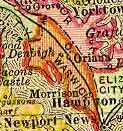
While no one knows for sure how Newport News got its name, most people think it was either because Captain Christopher Newport was a bearer of news to and from England or because, when he was cast away on Bermuda by the wreck of the Sea Venture, the news of his survival was received about the time he rounded the present Newport News Point.
What we do know is that the city was chartered in 1896 and joined with Warwick County in 1958 to become the present narrow city which is almost 20 miles in length. Its population is about 190,000.
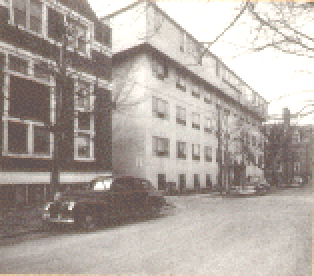
We’ll start our tour at the Riverside Regional Medical Center, the the flagship hospital of Riverside Health System. The Health System started with the 1915 charter for the “Newport News General and Non-Sectarian Hospital, Inc.” The original hospital contained 50 beds and was located on Huntington Ave. north of 50th Street in 1916. A nursing school was started at about the same time. The hospital was severely strained by a typhoid epidemic during World War I, as well as the influenza epidemic of 1918-19. It was expanded considerably during World War II.

The hospital moved to its current 56-acre location in 1963. It has 576 beds and is the primary center for medical care on the Virginia Peninsula. Its medical staff is comprised of over 400 physicians in 33 specialties. Riverside Regional Medical Center has always been an innovative force in medicine and medical education both locally and nationally, from the nation’s first CCU in 1965 to the country’s first web-based, competency-based evaluation system in 2001. It continues to evolve and improve and current capital projects include a 100 million dollar renovation project of the entire hospital.
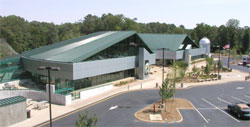
Past the hospital you will see the Peninsula SPCA on the left. On the right is the Virginia Living Museum, where you can “experience Virginia from the Mountains to the Sea,” with over 250 animal species and one of the largest displays of native plants in the commonwealth.
Newport News has many museums including: the Mariners Museum, the Peninsula (Civil War) Campaign Tour, the Army Transportation Museum, the War Memorial Museum of Virginia, the Peninsula Fine Arts Center, Newsome House, Lee Hall, and Endview Plantation.
Two roads run the entire length of Newport News, running parallel from the southeast (Newport News Point and Hampton Roads) to the northwest (Williamsburg). The city is long and narrow, and is bisected by railroad tracks built in the late 19th century to bring coal to the waterfront.

As we head west on Jefferson Avenue we come to the City Center of Oyster Point, an open-air gathering place, shopping district and central business district. Also on the right is the Thomas Jefferson National Accelerator Facility, a U.S. Department of Energy Office of Science national laboratory which houses a unique particle accelerator, the Continuous Electron Beam Accelerator Facility (CEBAF).
On the left-hand (western) side of Jefferson Ave. is Port Warwick, a quaint mixed use pedestrian-oriented community, named for the fictional city in Newport News native William Styron’s 1951 award winning novel, Lie Down in Darkness.
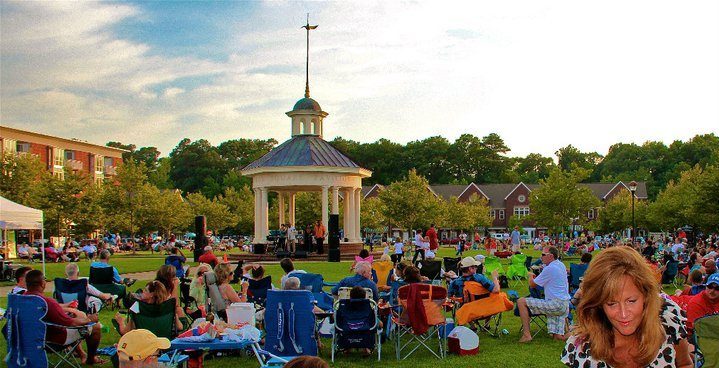
At the busy intersection of Jefferson Ave and Oyster Point Rd we find Newport News’ latest major development, Marketplace at Tech Center, featuring dining and shopping, anchored by Whole Foods. There are also several residential areas favored by our residents.
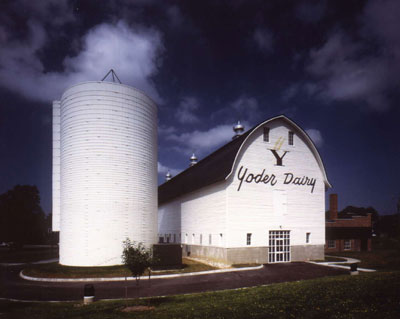
As we cross Oyster Point we enter the Patrick Henry district. The first area on the right was a large Mennonite farm. When the area was developed the Yoder Dairy barn was moved a few hundred yards to its current site, and converted into a live performance theater owned by Christopher Newport University.
After crossing over the interstate we come to Newport News’ largest residential and commercial development, Kiln Creek, and the Williamsburg/Newport News International Airport. This entire area was originally the 1700 acre Camp Patrick Henry, a staging area for World War II Army Air Corps troops. All told, 1,412,107 soldiers were processed through the Camp during the War. The airport was later repurposed for civilian use and opened in 1949. It still retains the original airport code, PFA (Patrick Henry Field)!
After leaving the airport we travel west to Denbigh Blvd and turn right, then right on again on Old Denbigh and turn into the grounds of The Gardens at Warwick Forest. This was built in 1985, was originally called Patrick Henry Hospital, then Patrick Henry Healthcare Center, and subsequently Riverside Regional Convalescent Center. It is the primary location for our nursing home geriatrics curriculum, and the adjacent Warwick Forest Retirement Community gives our residents further instruction in ambulatory geriatrics.
The large group of communities in northern Newport News called “Denbigh” take their name from a colonial plantation of the same name. The unincorporated community or town of Denbigh served as the seat of Warwick County for most of the years from 1810 to 1952. Warwick County briefly became an independent city itself, but then merged with the City of Newport News in 1958 at which time Warwick County — which had existed as Warwick Shire since 1634 — ceased to exist. But Denbigh lives on!
Head back to Jefferson Ave and turn right; it’s about 4 miles to Newport News Park, the largest municipal park east of the Mississippi. There are multiple bike and hiking trails; boating, fishing, and canoeing; as well as a large campsite. This is also the site of the annual Celebration in Lights, one of the largest holiday light shows in the Southeast.
Newport News Park is the location of one of Magruder’s lines of defense during the Civil War. By digging canals and constructing earthworks, the Confederates effectively delayed McClellan’s advance to Richmond. The park is on the site of the “real line of defense positions,” also known as the second defense, which ran from Fort Crawford on Mulberry Island (later Fort Eustis), up the Warwick River to Lee’s Mill, and on to Yorktown. The creeks, canals, and mill ponds eventually became the Newport News Reservoir, and the earthworks can still be seen in the park.
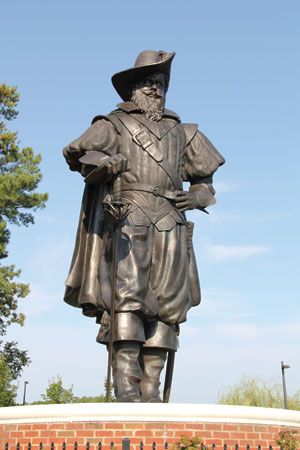
Heading back up Jefferson, pass Jefferson Commons shopping area (home of Trader Joe’s), turn right on Bland Blvd and, in 1 mile, left on Warwick. Note Young’s Mill on the right side of Warwick. After passing the Hidenwood neighborhood we’ll make a right on the Avenue of the Arts and see Christopher Newport University and the Ferguson Center for the Arts, and the statue of Christopher Newport. Wind around past the entrance to CNU and then down Shoe Lane. Take a left on Country Club Lane, then take a right on Central Parkway and enjoy the beautiful view of the James River before turning left onto Riverside Drive.
As we continue along the river, turn right on Museum Drive and drive around the back side of the Mariner’s Museum. In the distance, past the James River Bridge, you can see the Northrop Grumman Newport News Shipbuilding. On our left is the grounds of the Mariners’ Museum. It was started in 1931 by Mr. Huntington’s son and daughter-in-law, Archer M. and Anna Hyatt Huntington. The latter was an accomplished sculptress, and on our left, you can see the statue (Conquering the Wild) she did in tribute to her father-in-law. We will cross the “Lions Bridge,” named for the Lions she sculpted on each end, which extends over a dam the couple constructed on Waters Creek in 1932 to form Lake Maury. The Mariner’s Museum is the premier maritime museum in the World.
Newport News Shipbuilding and Drydock was started by Collis P. Huntington, who made his fortune selling groceries and supplies to miners in the California Gold Rush. He had a vision of a transcontinental railroad and, after deciding the Atlantic terminus would be in Newport News, he bought up land and right-of-ways from the Peninsula west to Richmond and beyond. The coal business flourished after the Civil War, and Mr. Huntington soon realized that a shipyard would be very useful to repair his coal ships. It was started in 1886, and a rather rough town continued to grow up around the coal yards and shipyard. He hired an architect to lay out Newport News and it was granted a city charter by the Virginia General Assembly in January 1896. The shipyard earned U.S. Navy contracts right from the beginning and has continued to be one of the most active shipbuilders for the U.S. The shipyard has grown to become the second largest employer in the Commonwealth of Virginia.
We will continue along the James River (jogging a little left and right) until we arrive at historic Hilton Village. Listed in the National Register of Historic Places, it was the first planned community in the United States, built by the Federal Government during World War I to house shipyard workers and their families. The streets are named after shipyard and city administrators of the time. It is a beautiful neighborhood with wide, tree-lined streets and charming, English-style homes.
Turning on to Main Street, we will cross back over Warwick Boulevard. On the right is the Main Street Library, one branch of the large, extensive, Newport News Public Library System. Duck under the railroad bridge, and we’re at the Riverside Hilton Medical Complex which is the new home for the Riverside Medical Library and the Riverside School of Nursing. Keep going straight to the traffic light and turn left onto Jefferson Avenue. About half a mile on the right is the VCU Riverside Family Medicine Residency located in the Riverside Brentwood Medical Center.
We hope you’ve enjoyed this “virtual tour” of our beautiful, historic city. We look forward to the time when we can show you around in person. There’s lots more to see!
Although we’ve linked to some of these above, here are some other links relating to Newport News and Hampton Roads:
- Virginia
- City of Newport News
- Christopher Newport University
- Newport New/Williamsburg International Airport
- Virginia Living Museum
- The Mariner’s Museum
- Riverside Health Systems
- The Daily Press
- Hampton
- Hampton University
- Old Dominion University
- Norfolk International Airport
- Virginia Beach
- The Virginian Pilot
- Williamsburg
- Colonial Williamsburg
- College of William and Mary
- Historic Jamestown
- Yorktown
- Colonial National Historic Park
- Busch Gardens
- Water Country USA
- Chesapeake Bay Bridge Tunnel
